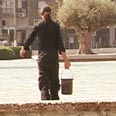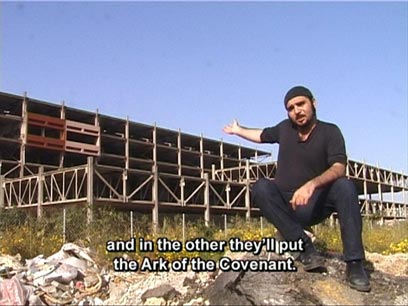
Palestinian art show in Herzliya Museum
'Men in the Sun' exhibition displays works depicting 'visual cultural field of Palestinian minority in Israel,' curator says, adds show aims to 'create a dialogue about the Palestinian identity of 1948'
When asked whether his work represents the Palestinian story, or comes from a place of more personal reflection, artist Raafat Hattab said he would prefer each person interpret his art from their own point of view and not have it dictated in the catalogue. He urged visitors to first see the work, and then read.

From Scandar Copti and Rabia Buchari's video on Jaffa
Tal Ben Zvi, one of the exhibition's curators, said, "One of the most important things about the exhibition is the fact that the pieces are created in the context of the Palestinian visual culture, and that this is a chance to see the cultural field of the Palestinian minority in Israel and see the link between the artists and the pieces."
Curator Hanna Farah - Kufer Bir'am said the show makes a statement, since it is a group that creates from within the Palestinian society, and not one in which each individual creates on their own.
"As an architect and a curator, I built, along with Ben Zvi, a show that has no hierarchy. The collection of pieces was broken down and the exhibition was built by merging the artists together," he said.
Ben Zvi added: "This is an exhibition that is based on a community that already exists historically. Through these articles we would like to create a dialogue about the Palestinian identity of 1948, as opposed to the identity in the diaspora or in the Palestinian Authority.

Piece by artist Ibrahim Nubani
"This show has two main elements – a feeling of temporality and silence, and actually talks about the Palestinian silence that has the opposite effect: Crying out."
The motif of location and territory is present in a large part of the works. For example, a video piece by Raafat Hattab shows him stroking and watering an olive tree with a love song about the feeling of belonging to the Palestinian community playing in the background.
Hattab toys with the allegory of uprooting and the right of return, and then makes a surprising twist, as he backs up with the camera only to reveal that the scene was shot in Rabin Square in the center of Tel Aviv.
In their video piece, artists Scandar Copti and Rabia Buchari pose as tour guides walking around the most un-touristy sites in Jaffa, and narrate the place's history to anyone that will listen.
Unlike the more ironic videos, some works focused more on immediate symbolism, such as that of Osama Said, whose piece featured a severed olive tree, while Abed Abdi's piece showed refugees in an unidentified place. Artists Durar Bacri and Rani Zahrawi displayed images of abandoned houses.
The exhibition will be on display at the Herzliya Museum of Contemporary Art until September 13, 2009.










